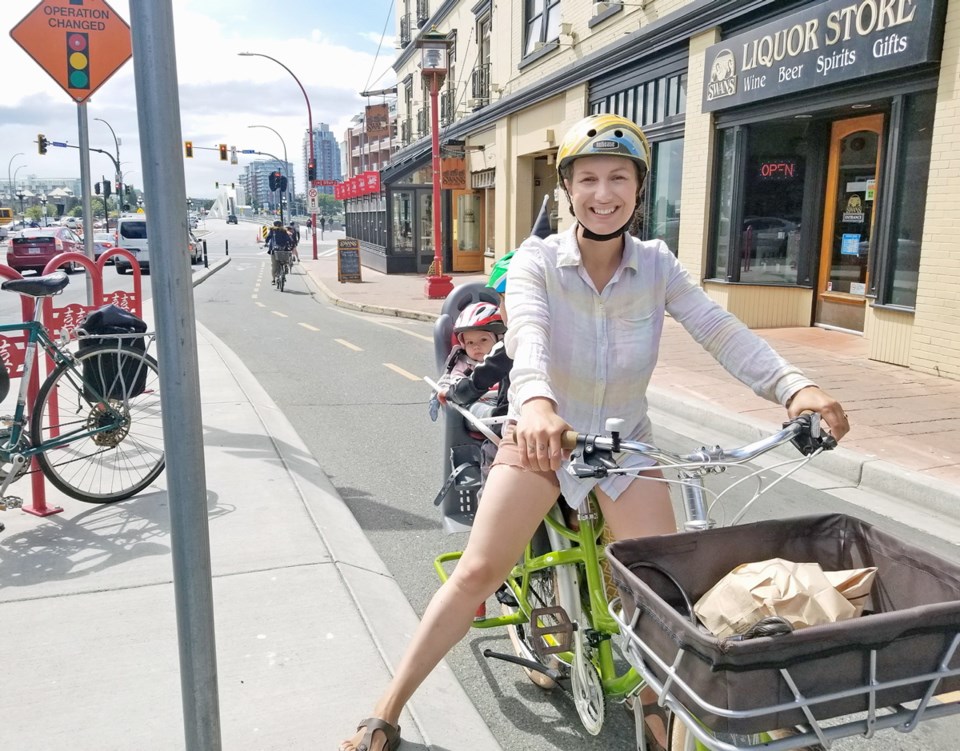My loaded cargo bike weighs about 250 pounds, carrying myself, my two kids, a bag of flour in the front basket and my chunky yellow diaper bag affixed as a panier.
My five-year-old has stuck a pirate flag in the back of his sister’s seat. We look like a colourful galleon floating on two wheels as we cross the Johnson Street Bridge and enter the bike lane for our first ride in one of Victoria’s new all-ages-and-abilities bike lanes.
As we begin to pedal up Pandora toward Government Street, in a line of other cyclists, I am overwhelmed by emotions and have to stop, one foot on the median to balance my load, while tears of joy flow down my cheeks.
Victoria, never for a minute let yourself doubt the importance of protected bike lanes.
I have lived in Victoria for nearly a decade, and cycling was a big part of my life here, before I had children.
I grew up in a rural area where I biked in the rain up and down gruelling hills on a gravel shoulder. I fell in love with urban cycling when I moved to the city after high school: First in Montreal, and then in Victoria.
After getting used to the protected bike lanes in Montreal, I needed a bit of a tuneup from a close friend, who insisted I learn to ride more defensively in Victoria. Once I found the safest routes and learned to ride with the cars, I loved being a full-time cyclist in this city.
Then, I had my first baby. My recent ride on the all-ages-and-abilities bike lanes downtown was the first time I really rode a bike since my eldest was born five years ago. It’s one thing to have to ride defensively when it’s just you on a bike: it’s another thing to do so with your tiny human in tow. I couldn’t do it, until now.
Last fall, knowing that climate change was top of mind for me after the UN report came out giving us 12 years to clean up our act or lock in runaway climate change, my family gifted me a used cargo bike for my 30th birthday.
This bike is capable of safely carrying both my children, and I quickly began taking it on joy rides around my Saanich neighbourhood. New technologies like e-assist and the variety of cargo bikes now available are making it possible for more people to ditch their cars. But in order for me to feel safe riding with my kids, I need protected bike lanes and trails.
I can’t risk riding with traffic, as even a minor crash is normally devastating for people on bikes, and when riding with traffic, crashes are not unlikely. In fact, I was hit by a truck while riding in a painted bike lane on Yates Street in 2013, pre-kids. Thankfully, I came away unscathed, but my bike was damaged, and I was thrown several feet. I lay, crumpled under my bike, while the driver drove away as if nothing had happened. A scan of local news headlines from last summer tells me that I am far from alone in this type of experience.
It is no longer outlandish or far-fetched to want networks of protected bike lanes in our cities: it is the only way forward. We must begin to rebuild our cities in ways that allow and encourage citizens to get out of our cars, and we must do it fast. My tears that day on Pandora were a mixture of hope, fear for the future and nostalgia for the easy summer I spent riding my creaky old bike along the bike lanes of Montreal and the years I spent car-free in Victoria before having kids.
See you in the bike lanes, on the Galloping Goose, and the Lochside trail, friends! Let’s change our culture, not our climate.
Elise Velazquez (Cote), a mother of two young children, is back cycling after parking her bike five years ago.



